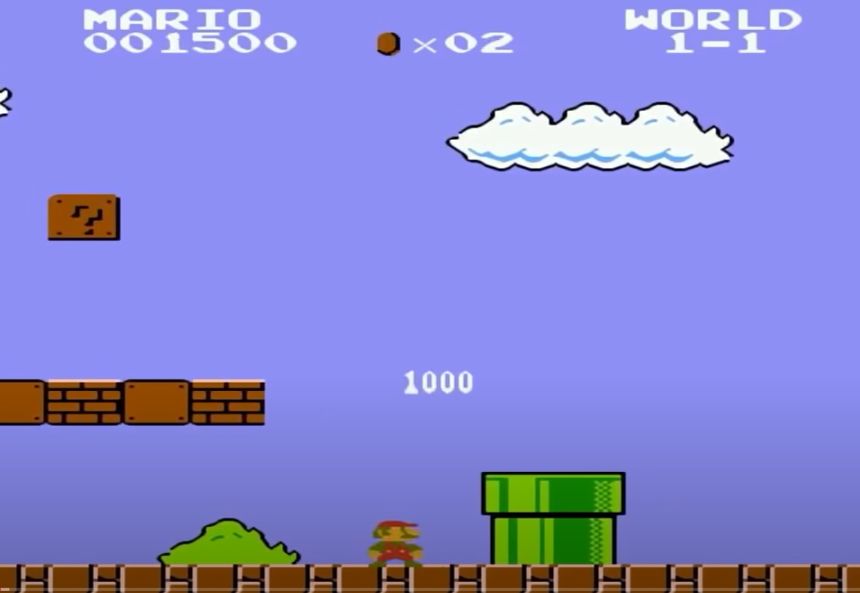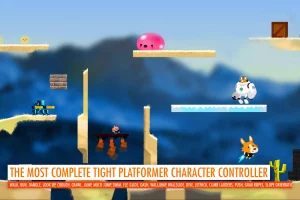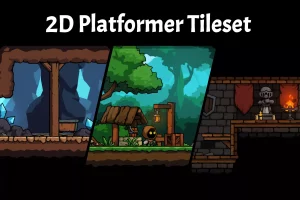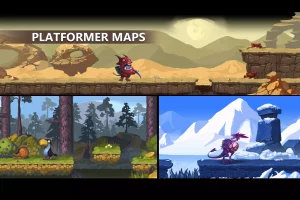How to Make a Platformer Game
A platformer game is a type of video game where the player character jumps between platforms or obstacles to advance in the game. Platformer games are usually 2D side-scrollers, but there are some popular 3D platformers as well. The player’s goal is to navigate the character through a series of levels, usually culminating in a final boss battle.

With the right tools and some basic knowledge, you can create a platformer game that is both fun and challenging to play. In this post, we will outline the basics of how to make a platformer games, from creating the levels to adding in enemies and obstacles.
What You Need to Know
Steps to make a platformer game
Choosing Your Game Engine
The first step to making a platformer game is to choose a game engine.
A game engine is a software development environment designed for creating video games. It provides various tools and features that simplify the game development process, such as a physics engine, rendering engine, andcollision detection.
There are many different game engines available, but some of the more popular ones include Unity3D and Unreal Engine 4. If you’re just starting out, we recommend using Unity3D because it is relatively easy to learn and use. However, feel free to experiment with different game engines to see which one you prefer.
Once you’ve chosen a game engine, it’s time to start learning how to script. Scripting is the process of coding gameplay mechanics into your game.
If you’re using Unity3D, then you’ll need to learn C# or JavaScript. If you’re using Unreal Engine 4, then you’ll need to learn C++.
Not sure where to start? We recommend checking out some online tutorials or taking an online course. Coursera offers several great courses on game development, including an introductory course on Unity3D and a more advanced course on Unreal Engine 4.
Designing Your Levels
After you’ve learned the basics of scripting, it’s time to start designing your levels. When designing a level, you’ll need to consider the following:
- The size of the level
- The layout of the platforms and obstacles
- The placement of enemies
- The number of coins or other collectibles
- The location of the exit
You can use paper and pencil to sketch out your levels, or you can use level design software like Tiled. Once you’ve designed a few levels, you can start creating them in your game engine.
Adding Enemies and Obstacles
Once you’ve created your levels, it’s time to add some enemies and obstacles. Enemies can provide a challenge for the player and make the game more exciting to play. Obstacles can also be used to add difficulty, but they can also be used to create interesting platforming challenges.
One way to make a platformer game more challenging is to add enemies that can attack the player. This adds an element of danger and makes the player have to be more careful about where they go. There are a few different ways you can make enemy attacks. One is to have the enemy shoot projectiles at the player.
Another is to have the enemy touch the player to cause damage. You can also have the enemy touch the player to knock them back or off a platform. Experiment with different types of attacks to see what works best for your game.
Testing and Publishing Your Game!
After you’ve designed your levels and added enemies and obstacles, it’s time to test your game. Play through your levels and make sure they are fun and challenging to play. If you find any bugs, be sure to fix them before publishing your game.
When you’re ready to share your game with the world, there are a few different ways to do it. You can upload your game to an online platform like itch.io or GameJolt, or you can release it on Steam. You can also choose to sell your game commercially or distribute it for free.
Essential elements
There are a few key elements that are common in most platformer games.
- The first is the use of platforms, which can be either static or moving. These platforms provide a place for the player to jump and move around the level. In addition, platformer games often have obstacles such as spikes or bottomless pits that the player must avoid.
- Enemies are another common feature in platformer games. These enemies can range from simple creatures that wander around the level, to complex bosses that require strategy and skill to defeat.
- Leveling up the main hero is often essential to progressing in the game. As the player collects coins or defeats enemies, they will earn experience points that can be used to level up their character. This usually results in the player becoming stronger and more capable of defeating tougher enemies.
- Finally, most platformer games have some sort of goal that the player must reach, such as rescuing a princess or collecting all of the coins in the level. Once the player reaches this goal, they will typically be taken to the next level where they must repeat the process.
With these elements in mind, you should have everything you need to get started on making your own platformer game!
Unreal Engine
Tutorials
Making a 2D Platformer in UE4 can be a fun and rewarding experience, and in this playlist, the presenters go over everything you need to know to get started. We will learn to create a simple 2D platformer in UE4 using the Paper2D systems inside of the Unreal Engine.
How To Make a 3d Platformer In Unreal Engine 4
In this course, you will learn everything you need to know about making a 3d Platformer game with enemies, different platforms, and more with blueprints in Unreal Engine. The course will go over how to create a 1UP system, coin collection, damage system, health system, moving platforms, enemies, and more.
You will also learn how to create a boss fight with a health bar and enemy AI. By the end of this course, you will have developed a strong understanding of Unreal Engine Blueprint system and you will be able to save game variables. This course is ideal for anyone who wants to learn how to make a 3d Platformer game in Unreal Engine.
Unity
Gamekits

The Corgi Engine is the most complete platformer solution for Unity, packed with more than 50 demo levels and 300+ ready-to-use visual assets. It's built around a tight character controller that will give your game the best possible experience on desktop, mobile, and everywhere you want. The Corgi Engine is also filled with 200+ optimized scripts and tons of ready-for-production prefabs. So if you're looking for the best platformer solution for Unity, look no further than the Corgi Engine.
It comes with MMFeedbacks built-in, allowing you to improve your game feel natively with just a few clicks. Add up to 40 feedbacks to every action or event in your game.
The Inventory Engine, usually sold separately but offered with the Corgi Engine, allows you to manage inventories, items, ammo, and customize and extend everything!
The Advanced AI system lets you create complex enemy, boss, or friendly AIs behaviors. With the Corgi Engine, you can create sophisticated games with incredible gameplay and graphics.
Assets

2D platformer games are some of the most popular video games out there. They're easy to pick up and play with, and they're a lot of fun. If you're thinking about making your own 2D platformer game, you're going to need a tileset.
This 2D platformer tileset is packed with everything you need to create an amazing game. From forests and caves to dungeons and snow, we have all the environmental assets you could possibly need. Plus, it has a huge cast of characters, including an animated main character, 15 animated enemies, 5 animated NPCs, and 311 multiple props.

Platformer games are always more fun when the environment is well designed. With this platformer map asset pack, you'll get three different types of maps to choose from- desert, forest, and winter landscape. All elements are in PNG format so they're easy to work with.
You also get an example map in PSD format to give you an idea of how everything fits together. And as a bonus, you get some extra art assets like boxes, barrows, and wooden parts. All the art is high resolution so your game will look great.
Python
Tutorials
Creating a Mario Maker style game in Python
The video explains how to make a game like Mario Maker using Python. This involves building a level editor, designing enemy behavior and animations, creating menus, and setting up a player camera. It's a big project with lots of different parts to it.